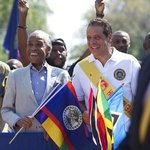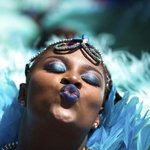The Labor Day Parade or West Indian Carnival is an annual celebration held on American Labor Day (the first Monday in September) in Crown Heights, Brooklyn, in New York City. The main event is the West Indian Day Parade, which attracts between one and three million participants. The spectators and participators watch and follow the parade on its route along Eastern Parkway. Some of the Caribbeanislands represented in the parade include Trinidad and Tobago, Haiti, Barbados, Dominica, Saint Lucia, Jamaica, Saint Vincent and Grenada, along with some Afro-Panamanians. mainland Caribbean countries such as Guyana, Suriname, and Belize also participate as well.
The 50th annual parade (September 4th, 2017) turned Crown Heights into an all-day party. Wave after wave of masquerading revelers and J’Ouvert stragglers danced and daggered their way down Eastern Parkway to Grand Army Plaza. The costumes was spectacular and the overall mood both raucous and light. Massive floats streaming a mixture of Caribbean jams — reggae from Jamaica, calypso from Trinidad and kompa from Haiti — started parading down the 2-mile route in Crown Heights at 11 a.m. It was expected to finish up around 6 p.m. on Flatbush Avenue.
The parade route was once again lined with tempting food stands. The sweet aromas of jerk chicken, curry and roasted corn swirled above the extravagant event. Older folks in folding chairs sat along the route, bobbing their heads to the music.
West Indian Day Parade 2017 on Instagram
[instashow id=”3″]
From Harlem…
Jessie Waddell and some of her West Indian friends started the Carnival in Harlem in the 1920s by staging costume parties in large enclosed places like the Savoy, Renaissance and Audubon Ballrooms due to the cold wintry weather of February. This is the usual time for the pre-Lenten celebrations of the Trinidad and Tobago Carnival and other related celebrations around the world. However, because of the very nature of Carnival, and the need to parade in costume to music, indoor confinement did not work well.

The earliest known Carnival street parade was held on September 1, 1947. The Trinidad Carnival Pageant Committee was the founding force behind the parade, which was held in Harlem. The parade route was along Seventh Avenue, starting at 110th St.
The first Carnival Queen was Dorothy Godfrey. The Committee raised money to finance the parade. They sold advertisement space and boosters, that were printed in a Souvenir Journal for West Indies Day, a booklet which is a memento of that first parade. Jessie Waddell Compton is presented in the journal as the person “whose inspiration and enterprise” was owed to the formation of this committee. The committee consisted of Waddell Compton-Chairman; Ivan H. Daniel-Vice Chairman; Conrad Matthews-Treasurer; Roy Huggins-Secretary; and Robert J. Welsh-Assistant Secretary. Each member of the committee contributed in helping to organize the parade. The after-parade party, which the Trinidad Carnival Pageant Committee held at the Golden Gate Ballroom, was arranged by James M. Green, another figure who helped make the first Carnival Parade in Harlem successful.
… to Crown Heights
The permit for the Harlem parade was revoked in 1964. Five years later, a committee headed by Carlos Lezama, which eventually became the West Indian-American Day Carnival Association, obtained approval for the parade to be established on Eastern Parkway in Brooklyn, where it remains today.





